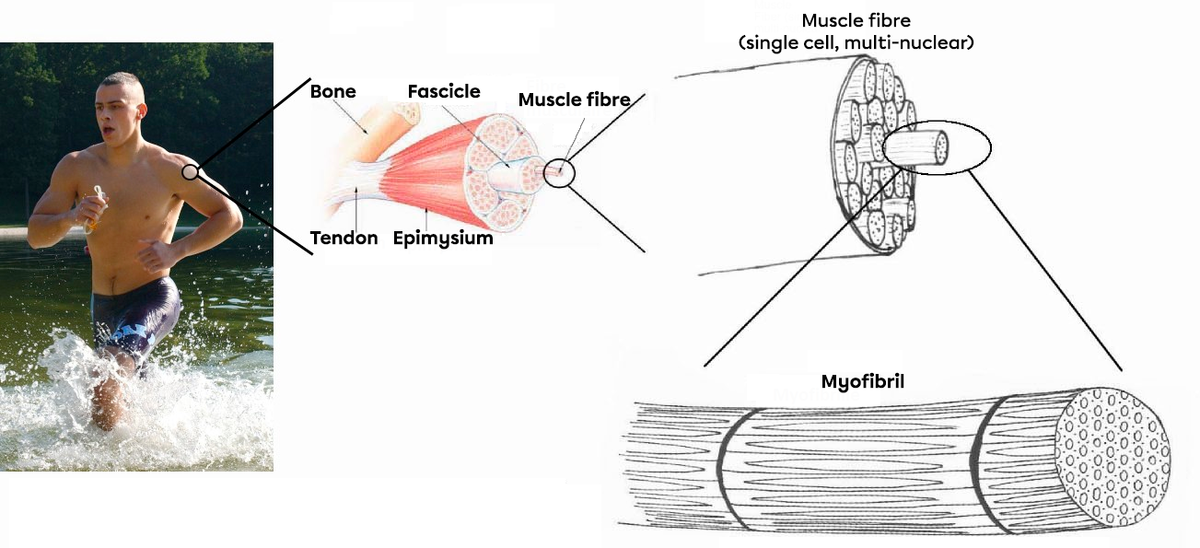There are over 640 muscles throughout the human body. Muscles attached to the bones by tendons allow different parts of the body to move by relaxing or contracting. Muscles can also stabilize joints, maintain posture and body temperature by releasing heat when they contract.
All the muscle fibres in the human body have 3 properties:
-
They are excitable, meaning that they can be stimulated with an electrical current.
-
They are contractile, meaning they can shorten when stimulated.
-
They are elastic, meaning they always return to their shape after contracting or stretching.
There are 3 categories of muscle tissue: skeletal muscle, smooth muscle and cardiac muscle.

Skeletal muscles, also called striated muscles, are attached to the bones of the skeleton and are voluntarily controlled. The alternating dark and light bands give this type of muscle the appearance of being striated. They can exert a great deal of force, but only for a short period of time. They need to rest between intense activities. They have low endurance.
Smooth muscles, on the other hand, are controlled involuntarily. They’re found in the walls of internal organs such as the stomach, blood vessels and bladder. This type of muscle is not as strong as the skeletal muscles, but they have much more endurance, working slowly over long periods of time.
Cardiac muscle is only found in the heart. It is involuntary and has a slightly striated appearance, which is a combination of the characteristics of the other two types of muscles.
Strength and Endurance
Muscle strength depends on several factors, including the number of muscle fibres used for contraction, the size of the fibres, the frequency of stimulation and the level of stretching of the muscle. Several changes occur in the muscles during regular physical activity which can bring about changes in the muscles, notably an increase in endurance and/or strength.
Aerobic, or endurance, exercise (e.g., swimming, jogging, biking, etc.) increases capillary vascularization of the muscles by up to 10%. In addition, the mitochondria inside the muscle cells increases in size and up to 80% more myoglobin is secreted. Myoglobin is the pigment that muscles secrete to capture oxygen. This provides additional oxygen to the muscle tissue during exercise and more efficient metabolism. As a result, there is an increase in endurance, strength and resistance to fatigue. Muscular hypertrophy, however, isn’t associated with aerobic exercise, which mostly involves oxidative (oxygen-using, slow twitch) fibres, although changes occur in all fibre types.
Muscle-building, or high-intensity resistance training, results in muscular hypertrophy. For example, lifting weights and isometric exercises could allow an underweight person to increase their muscle mass by 50% in one year with a few minutes per muscle-building every other day. The process involves an expansion (or increase in volume) of the muscle fibres (not an increase in their number). The fibres involved are glycolytic fibres, which derive their energy from glycolysis, a process by which sugars are used in an anaerobic process. Anaerobic training therefore results in an increase in strength, the number of mitochondria, the number of myofilaments and myofibrils, as well as the storage of more glycogen, all of which is combined with an increase in the amount of connective tissue between the cells, leading to muscle hypertrophy. When it comes to staying flexible, it’s important to keep in mind that muscles work in pairs (antagonistic muscles such as biceps and triceps) and that one shouldn’t be favoured over the other.
All striated muscles have the same structure. Each muscle is made up of bundles, which are themselves made up of many muscle fibres, also called muscle cells. The bundles are held together by a membrane, called the epimysium. The red part of the muscle is called muscle belly and there are bands of whitish connective tissue at both ends that form the tendons. These are what attach the muscle to the bones of the skeleton.

Each muscle fibre itself is made up of smaller contractile units: myofibrils.
Muscles that have opposite effects, such as the biceps and triceps in the arm, are called antagonistic muscles. When the biceps contracts, the triceps relaxes, allowing the arm to flex. Conversely, if the biceps relaxes, the triceps contracts allowing the arm to extend.
